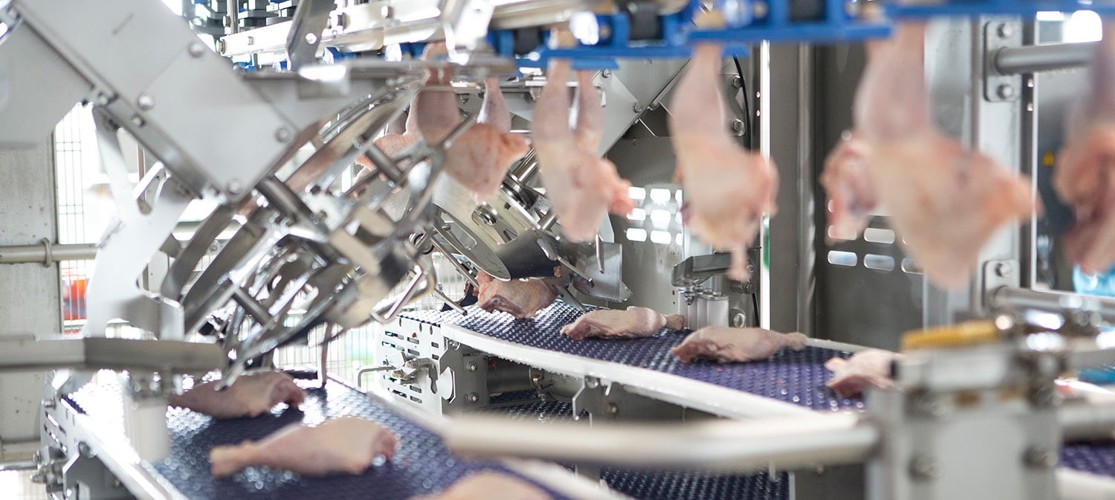These leg cut-up and batching lines are flexibly configurable, make the best possible use of product and assemble extremely accurate batches with minimum give-away.
The inline LegPositioner directly follows the leg modules of the ACM-NT cut-up system. It automatically unloads selected legs or drumsticks from the ACM-NT shackle and positions them perfectly on a belt conveyor, always at the same (adjustable) pitch and in the same fixed position.
Several downstream processes benefit. Catch-weight or fixed-weight retail packing becomes easier as products are always presented in the same ergonomically friendly way. Next, easy leg packing can be done in two ways: by RoboBatcher Flex and by a grader such as the SmartLine Grader with manual packing.
Perfectly positioning the leg
Furthermore, skin presentation improves because product is always positioned skin-up. Because less manual handling is needed, LegPositioner saves labor, improves hygiene and makes packing and styling jobs easy. LegPositioner also supports full inline traceability, even after legs have been released onto the conveyor belt.
LegPositioner gives more control over automatic infeed into a downstream process and makes it more reliable. This downstream process could be a freezer, an injector, deskinner, a belt grader or even ValueSpray as well as several batching solutions.
Two jobs
Marel’s RoboBatcher Flex is a well-known solution for fixed-weight fillet batching. It is, however, a very handy piece of equipment for batching drumsticks and whole legs too. Using either two or three cells, this flexible fixed weight batcher can run two individual tray jobs at the same time; separate jobs on left and right legs are possible if desired.
Running two jobs simultaneously will give better results. If the average weight is 300 g and the target weight is 1,100 g, then it will be optimal to run a 1,200 g job together with the 1,100 g job.
Intelligent batching
RoboBatcher Flex uses Innova PDS and integrated logistics to communicate with the ACM-NT cut-up line which will then fit legs into its recipe. No product discharge is needed with this system as the intelligent Innova PDS software co-ordinates feed from the cut-up line with the requirements for each tray. In this way, RoboBatcher can request legs of a certain weight and quality grade at the desired speed.
All robotic arms in the different cells can co-produce the trays; this cooperation is known as Common Lane batching. This ensures optimal product utilization and produces a regular flow of accurate, perfectly styled trays with no buffering of product.
The RoboBatcher system is for those processors producing fixed-weight trays for retail, who are looking for the lowest give-away or who want to cut labor costs. RoboBatcher Flex for leg products provides the very best in inline batching automation and minimizes the need for manual labor in the leg batching process.
Leg handling in practice: Amadori Italy
Some of the legs will enter the Drumstick Cutter module for the straightforward production of a fast food product. Bone-in thighs are cut off in this module and fall from the line. These bone-in thighs are then packed with the help of a PaceLine system.
Meanwhile, in both ACM-NT lines, the LegWeigher weighs the products and the Broken Leg Detector checks them for broken bones. LegPositioner then unloads selected products and positions them perfectly on two SystemFlex belt conveyors, always at the same pitch and in the same position.
Work together
Each line then goes its own way. On the one side, two conveyor belts take product from the LegPositioner to a 3-cell RoboBatcher Flex. Here, drums and whole legs (100 per lane per minute) are fixed-weight batched and automatically packed in trays.
The three robot grippers work together to form the perfect batch for each tray, so that all trays will end up being the same weight. As the RoboBatcher can handle two different jobs simultaneously, mixed drumsticks and whole legs on the belt are no problem at all.
Fixed-weight batching
On the other side, two belts convey whole legs or drums from the second LegPositioner directly to a packing station, where they are packed manually either bulk or catch-weight. Products not selected by the LegPositioners, stay in the ACM-NT overhead conveyor and are transported to either the thigh deboning system or to the fixed-weight overhead leg batching system.
On their way in the buffer line, products are assessed by Innova PDS, which calculates how to combine them to make up fixed-weight batches. The individual legs of a carefully weighed batch are then discharged from the overhead conveyor into one of the bins and packed for retail customers.
